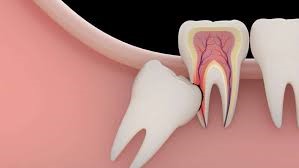Wisdom Teeth Removal
- Home
- Treatments
Wisdom teeth are even known as the third molars. They are usually the last set of teeth to erupt. According to dentists across the world, an individual generally gets the wisdom teeth in late teens or early twenties. But, even situations of the eruption in late adulthood are common. If the teeth erupt smoothly, without any interruption, they are proved to be an asset. But the problem with the third molars is that in the case they do not come up properly or if they are misaligned, then they require to be extracted. In case they are oddly aligned, they could damage the nearby tooth as well.

How does it work?
The requirement for removal of a wisdom tooth is determined by a professional dentist, who is generally the one who undertakes the procedure. The following are the different stages of the process of wisdom tooth extraction.
Wisdom extraction process
- Administration of Anesthesia – Before having the wisdom teeth removal procedure started, the patient would be given an injection of local anesthetic. This is done to numb the tooth along with the surrounding area.
- Removal of the wisdom tooth -If the wisdom tooth has come from the gum, then a small cut (incision) is made to access it. The tooth is cut into smaller parts to make it easier to remove from the opening. The process will require less incision if the tooth has broken through the gum.
- Winding up – If the incision is made, dissolving stitches would be used to seal up the gum. The stitches usually dissolve in 7 to 10 days. The dentist might place a gauze over the extraction site and ask the patient to keep pressure on the same by biting the jaws together for almost an hour
- Time taken -The time taken to remove the tooth varies from one patient to another. Simple procedures may require only a few minutes, but it might take more than 20 minutes if there are some complications.
Post-treatment care
For a day after removing the wisdom tooth, one must avoid:
- drinking alcohol and smoking
- strenuous physical activity
- rinsing your mouth out with liquid
- drinking hot liquids such as tea or soup
FAQs
Some of the most common symptoms of the appearing of the wisdom teeth are tenderness, discharge if it’s an abscess, pain in the jaw, swelling around the gums is present, or one can see it coming through the gum behind the second molar. Others, however, don’t possess any visible symptoms of the wisdom teeth pain.
After removing the wisdom teeth, it is normal to have swelling and bruising. These swellings improve after a couple of days but the bruising can take more time to clear up. The use of an ice pack is generally directed by the dentist.
Based on the complexity of the process of extraction, there are various anesthetic options which are administered to minimize the pain or any discomfort during the process of extraction.
If the wisdom teeth are impacted and or are causing crowding in the mouth, it is suggested that they must be removed to prevent damaging the nearby teeth. If they are grown correctly positioned, and function properly, it is not required to remove them.
